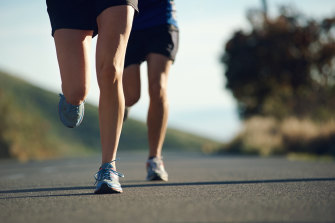If knee replacement surgery already seems like a rite of passage at a certain age, just wait until 2030. By then the current numbers – around 65,000 a year – are predicted to jump by 276 per cent thanks to increasing weight gain and an ageing population.
First twinges of knee pain should be a call to action – not just to lose weight or prevent gaining more – but to get levels of blood pressure and cholesterol checked too.Credit:iStock
Yet knee pain from osteoarthritis needn’t go hand in hand with ageing – or running. Research has shed new light on its causes, and we can forget blaming it all on “wear and tear”. The kilo creep is a major culprit, not only because it burdens the knee joint with extra weight but also because too much fat around the waist produces inflammatory chemicals that damage knee cartilage, explains Professor Flavia Cicuttini, head of Rheumatology at Melbourne’s Alfred Hospital and of Monash University’s Musculoskeletal Unit.
“We hear so much about the need to lose weight but the emphasis should be on preventing weight from creeping on in the first place. On average, Australians gain around half a kilo a year up until the age of 55 – yet it’s so much easier to avoid gaining 500g a year than it is to lose five kilos or more 10 years later.”
Besides, weight loss doesn’t do as much as you’d think to improve knee pain once osteoarthritis has set in – clinical trials have shown that a five to 10 per cent weight loss has only a modest effect, about the same as taking Panadol, she adds.
“The damage has already been done. But we should capitalise on the fact that avoiding or slowing further weight gain will prevent the early niggling joint pains we often experience in our 30s and 40s from becoming worse.
“Those first twinges of knee pain should be a call to action – not just to lose weight or prevent gaining more – but to get levels of blood pressure and cholesterol checked too,” she says. “Knee osteoarthritis and artery problems are interlinked – when you take an MRI of a knee with osteoarthritis you often see narrowing of the blood vessels as well as joint damage – it’s likely that these narrowed blood vessels are not delivering enough nutrients to the joint.”
Which is where recreational runners may be doing their knees a favour.
“People worry that running will wear out the knee joint but it can improve joint health by providing nutrition to the articulate cartilage of the knee by keeping the joint moving,” says Professor Ilana Ackerman, Deputy Director of the Monash-Cabrini Department of Musculoskeletal Health and Clinical Epidemiology at Monash University. “Recreational runners have lower rates of knee osteoarthritis compared to people running at an elite or competitive level, and compared to people living a more sedentary lifestyle.
“Runners can also do a lot to reduce the likelihood of knee pain – running on softer surfaces like grass rather than concrete, for instance – running for shorter distances and minimising downhill running. A physiotherapist can also help by checking your running biomechanics and giving advice on re-training your running gait, if necessary. ”
And lifting weights? That shouldn’t be a problem either – as long as you’re taught how to lift correctly and don’t lift a weight you’re not ready for, she adds.
But some injuries common in sports like netball, football and basketball can prime knees for osteoarthritis later on – like tears to the meniscus (the pad of cartilage cushioning the knee joint) and to ligaments attached to the joint, including the anterior cruciate ligament, Professor Ackerman says.
“As well as twisting and landing injuries in these sports, knocks to the outside of the knee joint can cause problems too. Preventing injuries to the knee joint is the best thing we can do to help head off future knee osteoarthritis. But if your knee is injured, you can still reduce the risk of osteoarthritis by seeing a sports physician or physiotherapist to get the right rehabilitation – and by maintaining your weight and staying physically active.
“As a community we’ve done a good job of reducing heart disease and skin cancer, for example, by being aware of the risk factors earlier in life – but we need more public awareness of how to keep our joints healthy across the lifespan,” she says. “Knee osteoarthritis itself might not be fatal but the immobility it can bring later in life can be very debilitating and also compound the effects of other diseases.
“Stay fit, stay strong and avoid weight gain as best you can. Some kind of aerobic exercise is essential for helping maintain a healthy weight and recreational running is one example of an exercise you can do without worrying it will cause knee damage,” she says. “And if you already have knee pain, a physiotherapist or exercise physiologist can design an exercise program that can help reduce pain and improve mobility.”
Make the most of your health, relationships, fitness and nutrition with our Live Well newsletter. Get it in your inbox every Monday.
Most Viewed in Lifestyle
From our partners
Source: Read Full Article

